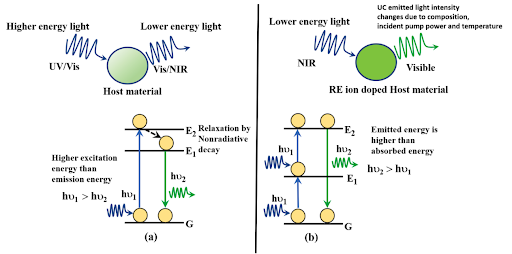
Up-Conversion/ down-conversion Fluorescence spectroscopy
Life time measurement:
Time-resolved spectroscopy is used to probe the dynamics of light up-conversion processes. The sample of interest is excited either with a pulsed or modulated light source, and when performing a typical time-resolved spectroscopy experiment, the total luminescence evolved over time is measured.
For life time measurement (in micro and millisecond) 980 nm laser and Xenon lamp source is used in pulse or modulated mode.
Time-correlated single-photon counting (TCSPC) is a well-established and common technique for fluorescence lifetime measurements (in Nano-second), and is measured using the Nano-LED source.
Quantum Yield Measurement:
The quantity Quantum Yield, η, is defined by the sum of all emitted photons, divided by the sum of all absorbed photons. The number of absorbed photons is given by the difference of the two scattered curves.
For the Quantum Yield measurement Quanta Phi Integrating Sphere equipped with the Xenon Lamp Source is used.
For any query related to the instrument,
Contact : Dr. Manisha (8512093400)
- Category Spectroscopy Facilities
- Availability Available
- Share on
Instrument's Description
Photon up-conversion (UC) was first explained by Bloemberg in 1959 and was able to differentiate and count the number of infrared photons using lanthanide and transition metal ions in a doped solid matrix. Following that, in 1960, François Auzel and his colleagues Ovsyankin and Feofilov conducted extensive research. In 1966 they predicted that the photon UC would occur via energy transfers between excited-state ions. A minimum of two low-energy excitation photons are needed for each higher energy emission photon, and the entire process is required to adhere to energy conservation principles. Low-power incoherent excitation sources, such as CW lasers can be used to achieve the upconversion process.
Sample Description
Price List
| For Internal usage Per Hour | 130 |
| For External (Academics) usage Per Hour | 1000 |
| For External (Industries) usage Per Hour | 2000 |


